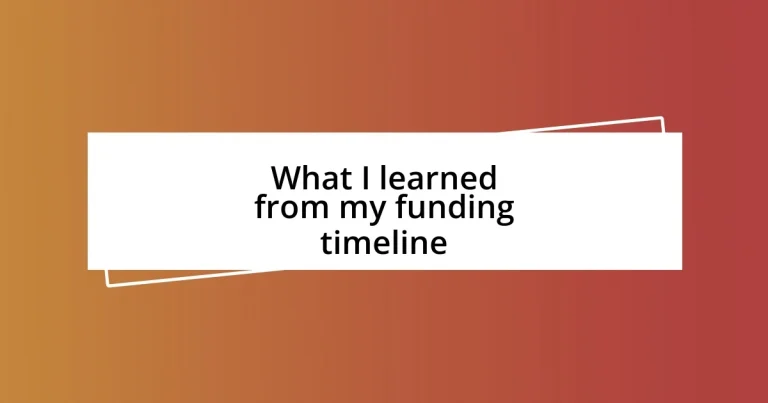Key takeaways:
- Clearly defined milestones and goals are crucial for clarity and motivation in the funding process.
- Building relationships and maintaining communication with potential investors significantly enhances fundraising efforts.
- Personalization, storytelling, and seeking feedback are essential strategies for successful funding applications.

Understanding the funding timeline
Understanding the funding timeline can feel like navigating a complex maze. I remember the first time I laid out my project’s timeline, staring at a blank calendar and wondering, “Where do I even begin?” This feeling of uncertainty is common, but recognizing the key stages of funding can help eliminate some of that confusion.
One of the toughest lessons I learned was the importance of clearly defined milestones. Early on, I thought I could simply wing it and find funding along the way. However, as I hit roadblocks, I realized that mapping out specific goals—and the timelines to achieve them—provided clarity and direction. It made me appreciate how every step, no matter how small, contributed to the larger picture of securing funds and building momentum.
Additionally, I found that maintaining communication throughout the timeline is crucial. When I first sought funding, I often hesitated to reach out to potential investors or partners. The fear of rejection loomed large. But as I began to share my progress and current needs, I discovered that most people appreciate transparency and are often more willing to help than I initially thought. This openness transformed my fundraising efforts and ultimately reinforced the idea that understanding the funding timeline is not just about tracking dates—it’s about building relationships.

Key milestones in funding progress
Key milestones are the critical markers along your funding journey that can simplify decision-making and keep you motivated. When I finally established my first milestone—completion of my initial pitch deck—I felt like I had crossed a significant boundary. It was an emotional win, affirming my resolve and igniting my passion for the project. Reflecting on this, I realize how every milestone can be a powerful reminder of progress and commitment.
Here are some key milestones in funding progress that I found essential:
- Identifying your funding needs: Understanding how much money you actually need can steer your journey right from the start.
- Creating a compelling pitch: This step isn’t just about the numbers; it’s about telling your story effectively.
- Networking with potential investors: Building these relationships early opens doors you might not even know existed.
- Securing your first meeting: Getting that first appointment with an investor can feel like winning a small battle—celebrate it!
- Receiving your first commitment: There’s nothing like that moment when someone believes in you enough to put resources on the line.
- Closing your first round: This is where the journey turns from theoretical to tangible—your vision is unfolding.
Each of these milestones serves as a touchpoint that keeps the momentum alive and fuels your passion as you move forward. Remember, every step—big or small—matters in the grand tapestry of your fundraising journey.

Importance of setting funding goals
Setting funding goals is the cornerstone of a successful fundraising strategy. In my own experience, I often found that having clear goals acted like a lighthouse during stormy seas. For instance, when I set a specific amount I wanted to raise by a certain date, it shifted my focus and efforts. Instead of drifting aimlessly, I could channel my energy into targeted actions, allowing me to track my progress more efficiently.
Moreover, a well-defined funding goal creates accountability. I remember when I partnered with a colleague to aim for a specific funding target. Sharing our goals not only motivated us but also kept us honest about our progress. It was eye-opening to see how mutual accountability can foster a collaborative spirit, making the entire process feel less daunting and more achievable.
Additionally, setting milestones along the way allows for strategic adjustments based on real-time feedback. When an initial goal felt unreachable, I learned to reassess and recalibrate rather than giving up. By viewing challenges as learning experiences, I could pivot my approach, which often turned setbacks into growth opportunities. Embracing this flexibility made all the difference in staying motivated and on track.
| Goal Type | Impact |
|---|---|
| Short-term goals | Help maintain focus and urgency |
| Long-term goals | Provide overall direction and vision |
| Quantitative goals | Enable tracking and measurement |
| Qualitative goals | Encourage relationship-building and storytelling |

Strategies for effective funding applications
When I started preparing my funding application, I discovered that personalization was key. Tailoring my proposal to resonate with the specific interests of each investor made a world of difference. For instance, when I learned about an investor’s passion for sustainable technologies, I wove that theme throughout my application. It wasn’t just about asking for money; it was about sharing a vision that aligned with their values.
Another strategy that I found pivotal was storytelling. Investors see countless applications, and it can be easy for them to tune out the facts and figures. I used anecdotes from my journey to create an emotional connection. I still remember the look on an investor’s face when I shared a personal story about overcoming challenges while developing my project. It was a powerful moment that brought my application to life and made it memorable.
Lastly, seeking feedback was invaluable. After drafting my application, I reached out to mentors and friends in the industry. Their insights were eye-opening and often highlighted areas for improvement that I hadn’t considered. Have you ever missed something glaringly obvious in your work? I certainly have! Embracing constructive criticism helped me refine my application, boosting my confidence and increasing my chances of success.

Lessons learned from funding experiences
Funding experiences often provide powerful lessons that can shape our approach moving forward. One important realization was the necessity of cultivating relationships early on. I still recall a conversation over coffee with a potential investor who ended up supporting my project. It struck me how building trust and rapport well in advance of a funding request can pave the way for smoother negotiations later. Have you ever found that the strongest support often comes from those whom you took the time to engage with?
Another lesson was the importance of persistence. I remember facing numerous rejections early in my funding journey, each one feeling like a punch to the gut. However, rather than allowing them to deter me, I began to view them as opportunities for growth. Every rejection prompted me to refine my pitch and strengthen my proposal. It was almost like turning those moments of disappointment into a form of resilience. Isn’t it fascinating how each setback can become a stepping stone toward eventual success?
Lastly, I learned that every funding experience is unique, and what works for one project might not work for another. Early on, I tried to mimic the strategies of successful peers, only to realize that authenticity in my approach was crucial. I remember a funding submission where I stayed true to my vision, even if it didn’t align with what I thought investors wanted to hear. The positive response I received reinforced the idea that staying true to oneself can attract the right partners. How often do we mistakenly think we need to conform to succeed?

Common pitfalls in funding processes
One common pitfall in the funding process that I encountered was the tendency to underestimate the time required for applications. I distinctly remember rushing through a proposal because I thought I could quickly fit it into my busy schedule. That decision led to a significant oversight: I failed to address key sections that investors commonly look for, ultimately resulting in my application being disregarded. Have you ever found yourself hastily completing a task only to regret it later? It’s a stark reminder that thorough preparation can’t be rushed.
Another trap many fall into is a lack of clarity in their funding goals. Early in my funding journey, I was vague about the amount I needed and how I would use it. This ambiguity made investors hesitant, which I realized was a mistake after receiving polite rejections. A clear, detailed breakdown of my funding needs not only helps the investor understand my vision but also shows that I’m serious about my goals. Did you know that specificity can actually inspire confidence?
Lastly, I learned that neglecting to follow up with investors after submitting applications can diminish your chances. I made the mistake of thinking my proposal would speak for itself. However, after a few months without hearing back, a friendly yet persistent follow-up email prompted several investors to revisit my application. It was amazing to see how simply demonstrating my continued interest could reignite their attention. Have you ever considered how a gentle nudge can make a difference? It’s all about maintaining those connections and showing that you care about the process.

Future outlook on funding trends
As I look ahead at funding trends, I see a shift toward more personalized and relationship-driven investment strategies. In a recent conversation with a fellow entrepreneur, we discussed how investors are increasingly prioritizing not just the numbers but also the passion and vision behind a project. Have you noticed how storytelling has become a vital part of pitching? It’s like creating a narrative that makes investors feel emotionally connected to your mission.
I also sense that sustainability and social impact are becoming dominant themes in funding discussions. Reflecting on my journey, I remember when I pitched a project focused on environmental conservation; the enthusiasm it garnered was electric. It made me realize that investors today are more eager than ever to support ventures that align with their values. Do you think aligning your goals with a broader social purpose can enhance your appeal to potential backers?
Moreover, technology is playing an ever-expanding role in how funding is sourced and secured. From crowdfunding platforms to blockchain-based investments, I’ve seen how innovation is reshaping our approach to raising capital. Just the other day, I stumbled upon a startup that utilized AI to match entrepreneurs with the right investors. Isn’t it intriguing to consider how our methods of securing funding will evolve in the coming years? It’s clear to me that staying abreast of these developments is essential for anyone looking to navigate the future landscape of funding successfully.














